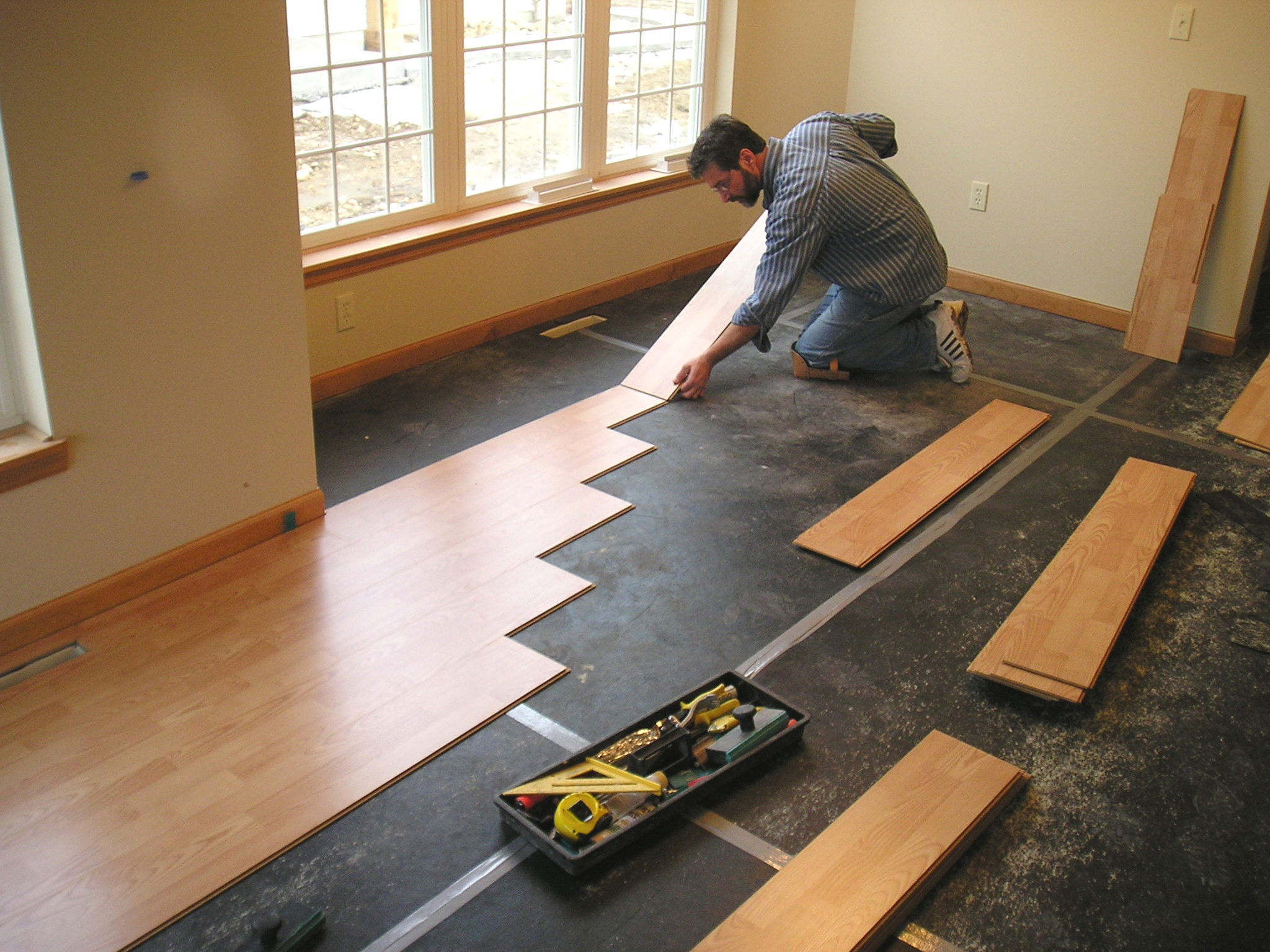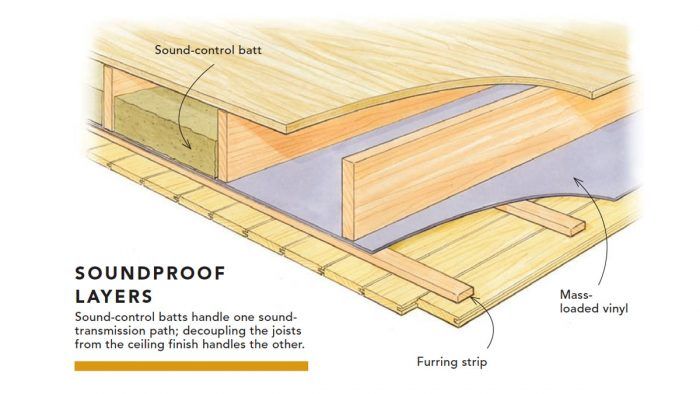Ever heard the thump of your neighbor’s footsteps above you, or the booming bass from a downstairs party? These are just a few examples of the annoyances that arise when sound travels freely between floors. Luckily, there are many solutions for soundproofing your home and creating a peaceful retreat for yourself and your family. Whether you’re dealing with a noisy neighbor or just want to create a more comfortable living environment, this guide will equip you with the knowledge you need to tackle the challenge of soundproofing between floors.

Image: baileylineroad.com
Soundproofing between floors is a crucial step in creating a quiet and comfortable living space, especially in multi-story homes. Understanding the science behind sound transmission and the different methods used for soundproofing can help you make informed decisions about the best solutions for your unique situation.
Understanding Sound Transmission
How Sound Travels Between Floors
Sound travels through vibrations. When a sound wave hits a surface, it causes the surface to vibrate, transferring the energy to the surrounding medium, and continuing the cycle. This can be likened to ripples in a pond. When a stone is dropped in, it creates ripples that spread out across the water, carrying the energy of the impact. Similarly, sound waves travel as vibrations through various mediums, including air, wood, plaster, and even concrete.
Sound transmission between floors occurs primarily through three pathways:
- Airborne Sound: This is the most common type of sound transmission. Sound waves travel through the air and pass through the floor and ceiling, reaching the other side. Examples include conversations, music, and television.
- Impact Sound: These are vibrations created by impacts on the floor. Foot traffic, furniture movement, and dropped objects are all examples. These vibrations transfer through the floor structure and into the ceiling.
- Structure-borne Sound: This type of sound travels through the solid materials of the building structure itself. Running plumbing, heating systems, and electrical equipment can cause structure-borne noise.
Factors Affecting Sound Transmission
Several factors can affect how well sound travels between floors, including:
- The Materials Used in the Floor and Ceiling: Some materials, like hardwood floors, are better at transmitting sound than others, like carpets.
- The Density and Thickness of the Building Structure: The more dense and thick the floor and ceiling structures, the better they will generally be at blocking sound transmission.
- The Presence of Gaps and Openings: Any gaps or openings in the floor or ceiling, such as those around pipes or electrical outlets, provide pathways for sound to travel through.
- The Frequency of the Sound: Low-frequency sounds, like bass from music, are more likely to travel through walls than high-frequency sounds, like voices.

Image: cinvex.us
Methods for Soundproofing Between Floors
The goal of soundproofing is to break the path of sound transmission. This can be achieved through a combination of methods:
1. Adding Mass to the Floor or Ceiling
One of the simplest ways to soundproof between floors is to add mass to the floor or ceiling. This can be done by adding drywall, plywood, or other heavy materials. The extra weight increases the density of the floor or ceiling, making it harder for sound waves to penetrate. It’s often a good idea to go beyond the standard single layer of drywall and consider using double layers of drywall with “Green Glue” or similar sound dampening adhesives in between.
Here are some examples of how to add mass to your floor or ceiling:
- Install a second layer of drywall: This is an effective way to add mass to the ceiling and improve sound insulation. Be sure to use a good sound-dampening adhesive between the layers for enhanced results.
- Use thicker drywall: Standard drywall is typically 1/2 inch thick, but thicker options like 5/8 inch drywall are available and offer increased sound-deadening properties.
- Apply a layer of Mass Loaded Vinyl (MLV): MLV is a highly dense material that effectively blocks sound transmission. It is available in rolls and can be easily applied to walls and ceilings using adhesive.
2. Adding Insulation to the Floor or Ceiling
Acoustic insulation functions as a sound absorber, converting sound energy into heat, reducing noise transmission. It is typically installed either between floor joists or between the drywall and underlying studs.
Common types of insulation used for soundproofing between floors include:
- Fiberglass Insulation: This staple for soundproofing provides cost-effective sound-absorbing properties, but can be messy to install.
- Mineral Wool Insulation: Mineral wool, commonly used for fireproofing, also offers excellent sound dampening properties and is less prone to settling than fiberglass insulation.
- Spray Foam Insulation: Spray foam is a powerful insulator that can be used to fill gaps and voids in the floor and ceiling, creating a continuous barrier against sound transmission.
3. Creating a Resilient Layer Between the Floor and the Ceiling
A resilient layer is a flexible material that is placed between the floor and the ceiling, decoupling the two structures. This reduces the transmission of vibrations and impact sound.
Common types of resilient materials used for soundproofing include:
- Sound Isolation Pads: These pads are made of rubber, neoprene, or other flexible materials and are specifically designed for soundproofing. They are typically placed between the floor joists and the subfloor to isolate the floor from the ceiling structure.
- Green Glue: A sound-dampening adhesive that is applied to the back of drywall to reduce vibrations. It is particularly useful for impact sound, such as footsteps.
- Concrete or Wood Resilient Channels: These channels, often made of metal or wood, work like spacers to create a gap between the floor and ceiling, allowing for more flexibility and better noise isolation.
4. Addressing Sound Bridges
Sound bridges are any pathways that allow sound to travel directly from one floor to another, bypassing the floor or ceiling structure. They can be as simple as a pipe or electrical wire running through a wall. Addressing sound bridges requires isolating them from the rest of the structure.
Some methods of addressing sound bridges include:
- Caulk and Seal Gaps: Seal every gap and opening in the floor and ceiling using caulk, weather stripping, or foam tape.
- Use Acoustic Sealants for Pipes and Conduits: Acoustic sealants are a specialized type of caulk that is designed to block sound transmission. Wrap pipes or conduits with acoustic sealant where they pass through walls or ceilings.
- Install Sound Isolation Sleeves: These sleeves are specifically designed to isolate pipes and conduits from the surrounding structure.
5. Adding Absorbing Materials to the Room
While soundproofing focuses on preventing sound from traveling between floors, sound-absorbing materials can further reduce noise reverberation within a room. This helps create a more quiet and comfortable atmosphere.
Examples of sound-absorbing materials include:
- Carpet: Carpet can be a simple and effective solution for absorbing sound, although the effectiveness varies depending on the carpet type.
- Curtains: Heavy curtains can help absorb sound as well. The heavier and thicker the curtains, the better they are at absorbing sound.
- Acoustic Panels: These panels are made of foam, fiberglass, or other porous materials that are specifically designed to absorb sound. They can add value to a room’s decor while simultaneously improving sound quality.
Tips for Choosing the Right Soundproofing Solutions
When selecting soundproofing solutions, it’s important to consider your budget, the severity of the noise issue, and your personal preferences. Here are a few key tips:
- Start with the Simplest Solutions: Try adding carpet, curtains, or a layer of drywall before investing in more complex solutions.
- Focus on the Problem Areas: Identify the source of the noise and target those areas with your soundproofing efforts.
- Get Professional Help When Needed: If you have a severe noise problem or are unsure about the best approach, it’s always wise to consult a professional soundproofing contractor.
- Don’t Forget About the Small Details: Don’t underestimate the impact of addressing small details like sealing gaps and isolating pipes. Even seemingly minor changes can make a significant difference.
Best Way To Deaden Sound Between Floors
Conclusion
Soundproofing between floors is an effective way to enhance your living space and create a more peaceful and enjoyable environment. By understanding the science of sound transmission, different soundproofing methods, and adopting a strategic approach, you can effectively address noise issues in your home. Remember to consider the specific source of noise, your budget, and your personal preferences when selecting solutions. By carefully planning and implementing the right combination of soundproofing techniques, you can make a significant difference in reducing noise levels, improving your quality of life, and enjoying a more peaceful home environment.





